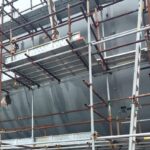Radiography Safety in Construction
Radiography, a crucial tool in the construction industry, plays a vital role in ensuring the structural integrity and safety of buildings and infrastructure. However, working with radiation also involves significant risks, making radiography safety in construction an essential aspect of radiography operations. This blog delves into various aspects of radiography safety, including what radiation is, its use in construction, radiation units, new technologies, associated hazards, control measures, and safety equipment.
What is Radiation?
Radiation is the emission of energy as electromagnetic waves or as moving subatomic particles. It can be classified into ionizing and non-ionizing radiation. Ionizing radiation, which includes X-rays and gamma rays, has enough energy to remove tightly bound electrons from atoms, creating ions. This type of radiation is commonly used in radiography due to its ability to penetrate materials and reveal internal structures. Understanding radiation is fundamental to ensuring radiography safety in construction.
The Use of Radiography in Construction
In construction, radiography is primarily used for non-destructive testing (NDT) to inspect the internal integrity of materials and structures. This technique helps identify defects such as cracks, voids, and inclusions in welds, concrete, and metal components without causing damage. By ensuring that critical structural elements are sound, radiography contributes to the overall safety and longevity of construction projects. Thus, radiography safety in construction is critical for maintaining structural integrity.
Different Units for Radiation: Metric and Other Systems
Radiation exposure is measured using several units across different systems:
- Sievert (Sv): The sievert is the SI unit of ionizing radiation dose, representing the potential biological effect of radiation. Commonly used subunits include millisieverts (mSv) and microsieverts (µSv).
- Gray (Gy): The gray measures the absorbed dose of radiation, representing the amount of energy deposited in a material. One gray is equivalent to one joule of radiation energy absorbed per kilogram of matter.
- Roentgen (R): An older unit used primarily in the United States, the roentgen measures the amount of ionizing radiation that produces one electrostatic unit of charge in one cubic centimeter of dry air.
- Rad and Rem: The rad (radiation absorbed dose) and rem (roentgen equivalent man) are traditional units used to measure absorbed dose and biological effect, respectively. One rad equals 0.01 Gy, and one rem equals 0.01 Sv.
Understanding these units is essential for implementing radiography safety in construction.
Comparing Radiation Units
While the SI units (sievert and gray) are more commonly used internationally, the roentgen, rad, and rem are still encountered in the United States. The sievert and rem measure biological effects, while the gray and rad measure absorbed doses. The key difference lies in the fact that sievert and rem take into account the type of radiation and its impact on human tissue, making them more relevant for safety considerations. Properly comparing these units is crucial for radiography safety in construction.
New Technology in Radiography
Advancements in radiography technology have enhanced both efficiency and safety in construction:
- Digital Radiography: This technology uses digital detectors instead of traditional film, providing quicker results, higher image quality, and reduced exposure times.
- Computed Tomography (CT): CT scanning combines multiple X-ray images to create detailed cross-sectional views of objects, improving defect detection accuracy.
- Real-Time Radiography (RTR): RTR systems allow for live imaging, enabling immediate assessment and reducing the need for repeated exposures.
- Portable X-ray Devices: Lightweight and battery-operated, these devices increase flexibility and safety in field inspections.
Adopting these technologies is a step forward in improving radiography safety in construction.
Hazards Associated with Radiography
Radiography involves exposure to ionizing radiation, which can pose significant health risks, including:
- Acute radiation sickness
- Increased cancer risk
- Genetic mutations
- Burns and radiation-induced injuries
Understanding these hazards is essential for ensuring radiography safety in construction.
Safety Control Measures
To mitigate these hazards, strict safety control measures are essential for radiography safety in construction:
- Time: Minimize the duration of exposure to radiation.
- Distance: Increase the distance between the radiation source and personnel.
- Shielding: Use barriers made of lead or other materials to block or reduce radiation.
- Administrative Controls: Implement procedures such as scheduling, access controls, and warning signs to limit exposure.
- Training and Education: Regular training ensures that personnel are aware of risks and safety practices.
Safety Equipment Used in Radiography
Several pieces of safety equipment are essential for protecting workers and ensuring radiography safety in construction:
- Dosimeters: Personal dosimeters measure the radiation dose received by workers, ensuring it stays within safe limits.
- Lead Aprons and Gloves: Protective clothing made of lead or other radiation-absorbing materials shields vital organs from exposure.
- Radiation Detectors: Devices such as Geiger counters and ionization chambers monitor radiation levels in the environment.
- Shielded Enclosures: Portable and fixed shields provide barriers to protect operators during radiographic procedures.
- Interlocks and Alarms: Safety interlocks and alarms ensure that radiation sources are properly secured and alert personnel to potential hazards.
Conclusion
Radiography is an indispensable tool in construction, offering critical insights into the internal integrity of structures. However, the use of ionizing radiation necessitates stringent safety protocols to protect workers from potential hazards. By understanding radiation, employing new technologies, and adhering to safety measures, the construction industry can effectively harness the benefits of radiography while ensuring the well-being of its workforce. Radiography safety in construction is paramount to achieving these goals.


